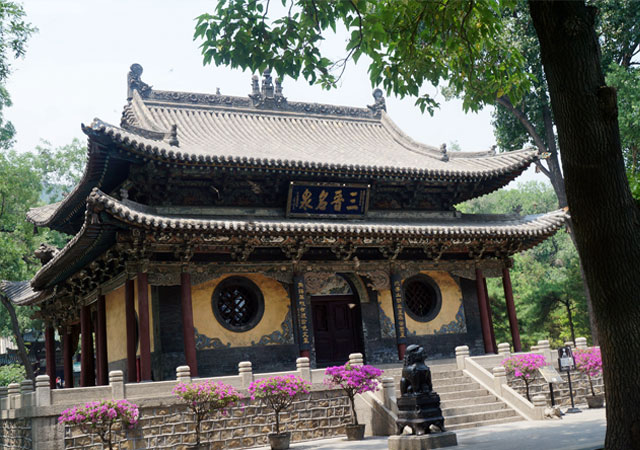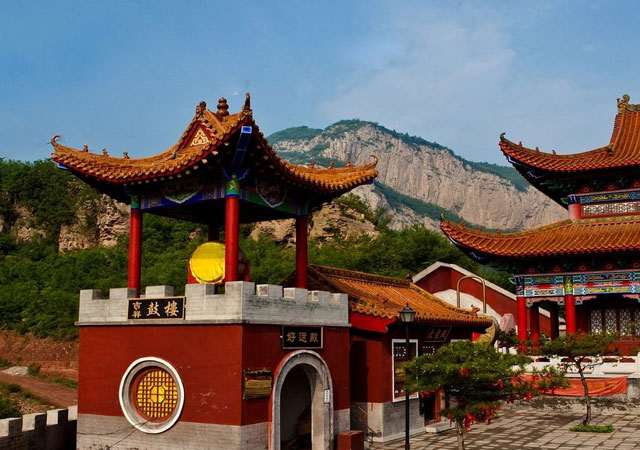
Tour Code: CDT-CDT01S
Destinations: Datong, Wutaishan, Changzhi, Jincheng, Linfeng, Pingyao, Taiyuan
Tour Duration: 10 Days
Tour Highlights: Nine Dragon Screen, Yungang Grottoes, Hanging Temple, Yingxian Wooden Pagoda, Pingyao Ancient City
Tour Features
This tour takes you to appreciate the best part of Chinese architectures in Shanxi province. The vernacular colored drawings on traditional buildings in Shanxi Province are of great value culturally, socially and economically, and are precious cultural heritages in need of conservation in the process of globalization and urbanization. Travelling inside Shanxi Province, you will explore the differences styles, structures and materials used in various regions.
Itinerary
Day 01 Datong (B)
 Arrive in Datong in the early morning. Meet your guide at the airport and transfer to the city area. After short refreshment at your hotel, visit Shanhua Temple which was originally built in the Tang Dynasty (618-907). It is the most intact and largest preserved temple of Liao and Jin dynasties in China. Continue to visit the Nine Dragon Screen, by far the most magnificent screens in China. Visit Yungang Grottoes in the afternoon. Yungang Grottoes are known as one of the three major Grottoes in China. The construction of the caves was started under the auspices of the noted monk Tan Yao in 453 and took 50 years to complete. Stay at the Garden Hotel this evening.
Arrive in Datong in the early morning. Meet your guide at the airport and transfer to the city area. After short refreshment at your hotel, visit Shanhua Temple which was originally built in the Tang Dynasty (618-907). It is the most intact and largest preserved temple of Liao and Jin dynasties in China. Continue to visit the Nine Dragon Screen, by far the most magnificent screens in China. Visit Yungang Grottoes in the afternoon. Yungang Grottoes are known as one of the three major Grottoes in China. The construction of the caves was started under the auspices of the noted monk Tan Yao in 453 and took 50 years to complete. Stay at the Garden Hotel this evening.
Day 02 Datong / Wutaishan (B)
Drive to visit Yongan Monastery, which was built in the Yuan Dynasty. Proceed to visit the Hanging Temple. According to the history of Hengshan Mountain, the Hanging Temple was first built at the end of the Northern Wei Dynasty (about the sixth century). Drive to visit Yingxian Wooden Pagoda. It is the oldest wooden structure extant today in China, and also the tallest among ancient wooden buildings of the world. Drive about 3.5 hours to Wutaishan Mountain. Stay overnight at Huahui Hotel this evening.
Day 03 Wutaishan / Taiyuan (B)
Visit Wutaishan Mountain, one of China's four sacred Buddhist Mountains. Drive about 4 hours to Taiyuan in the afternoon. En route have a short rest and visit local family. Check into the Yuyuan Hotel
 Day 04 Taiyuan / Changzhi (B)
Day 04 Taiyuan / Changzhi (B)
Visit Jinci Temple in the morning. Located at the foot of Xuanweng Mountain to the southwest of Taiyuan, Jinci Temple is one of the most important historical sites under special protection of Shanxi Province. Jinci Temple was built in the Bei Wei dynasty (386-534 AD) in memory of Shuyu, the second son of the Zhouwu kingdom. Drive about 3 hours to Changzhi in the afternoon. En route visit Dayun Temple at Qinxian. Dayun Temple was renovated in Song and Qing Dynasty and relics of fresco in Song Dynasty are kept at this temple. Stay at the four-star Dongming Hotel this evening.
Day 05 Changzhi (B)
Morning program features a visit to the Grottoes at Jindengsi Temple. When the grotto Art in China gradually began to dwindle in the Yuan Dynasty and almost ceased to develop in the Ming Times, the carvings of the Jindeng Temple Grottoes become naturally prominent in the history of Chinese grotto art. Many statues in the Jindeng Temple Grottoes had been severely damaged, some might not have artistic value, the geographical location of the temple, the sculptures on the outer walls of the grottoes, the structure of cave no. 5 and the various and rich content of the carved pictures and the single sitting statues of Buddha in those minor caves displayed high artistic value and great humane connotation that worthy of further study.
Visit Dayunyuan Temple, one among the five preserved wooden architectures which were built in Five Dynasties. Continue to visit Longmen Temple. It was built in the Northern Qi Dynasty. Combined with architectures of Tang, Song, Jin, Yuan, Ming and Qing together, the existing buildings can be described as a wealth natural scenery and cultural landscape with high value of study.
Day 06 Changzhi / Jincheng (B)
Drive from Changzhi to Jincheng. Visit Zhenze Er Xian Gong and Kaihua Temple on the way. Originally built in the Tang Dynasty, the Kaihua Temple is located in the mountainside of Sheli Mountain, 17 kilometers southeast of Gaoping City. It comprises of Drum Tower, Grand Hall and Yanfa Hall. In the Grand Hall, the exquisite frescoes painted in the North Song Dynasty are of great value.
 Visit the Yuhuang Temple in the afternoon. Yuhuang Temple, also called Yuhuang Palace in the past, is the largest and the most influential Taoist temple in old Zezhou. A great numbers of statues from the Song, Jin, Yuan, Ming (1368-1644), Qing Dynasties are kept at the temple. There are vivid painted sculptures, stone carvings, wood carvings, and colored glaze ware, and it is called “Treasury of carvings”. The work “The gods of the 28constellations”of the famous sculpture Liuluan from Yuan Dynasty are remarkably true to life. Stay at the four-star Fujing International Hotel this evening.
Visit the Yuhuang Temple in the afternoon. Yuhuang Temple, also called Yuhuang Palace in the past, is the largest and the most influential Taoist temple in old Zezhou. A great numbers of statues from the Song, Jin, Yuan, Ming (1368-1644), Qing Dynasties are kept at the temple. There are vivid painted sculptures, stone carvings, wood carvings, and colored glaze ware, and it is called “Treasury of carvings”. The work “The gods of the 28constellations”of the famous sculpture Liuluan from Yuan Dynasty are remarkably true to life. Stay at the four-star Fujing International Hotel this evening.
Day 07 Jincheng / Linfen (B)
Drive about 4 hours from Jincheng to Linfen. En route visit Fencheng ancient architectural complex. The Fencheng ancient architectural complex is located 16 kilometers west of the town proper of Xiangfen. With a long history, the group of buildings was originally the castle of Yuchi Gong, Duke of Er of the early Tang Dynasty and later rebuilt and extended in the Tang, Ming, and Qing dynasties, which left Fencheng with an impressive array of ancient buildings. Arrive in Linfen. Proceed to visit Guangsheng Temple and Water God Pagoda. The Guangsheng Temple was set up in the first year (147) of the Jianhe reign of the Eastern Han Dynasty (25-220). The temple was damaged in an earthquake in the 7th year (1303) of the Dade reign of the Yuan Dynasty (1271-1368), and was rebuilt in the following years. The temple is divided into three main parts: the upper temple, the lower temple and the Water God Temple. The Water God Temple is next to the lower temple. Their walls are connected with each other. The Statue of Ying, emperor of the Ming Dynasty, is enshrined there and frescoes about Yuan Dramas in the temple are world famous. Stay at the four-star Golden Bay Hotel this evening.
Day 08 Linfen / Pingyao (B)
Drive about 3 hours to Pingyao Ancient City, one of the 4 ancient cities well preserved in China and it was evaluated as the most outstanding heritage in the world by UNESCO in 1997. Visit Wang Family’s compound en route. Check in the Pingyao International Financial Club upon arrival.
Day 09 Pingyao / Taiyuan (B)
 Full day explore the ancient town of Pingyao: walk on the city wall and shop at the Ming & Qing Streets. Continue to visit Shuanglin Temple. The Shuanglin Buddhist Temple is part of the World Heritage Site of Pingyao. It was founded 1400 years ago in the 6th century during the Northern Wei period. The buildings were extensively renovated during the Ming Dynasty. It is famous for its collection of over two thousand decorated clay statues dating from the 12th-19th centuries. The statues are distributed among 10 halls in three connected courtyards. They are indeed a valuable treasure in the field of art. Transfer to Taiyuan in the late afternoon. Check into the four-star Yuyuan Hotel.
Full day explore the ancient town of Pingyao: walk on the city wall and shop at the Ming & Qing Streets. Continue to visit Shuanglin Temple. The Shuanglin Buddhist Temple is part of the World Heritage Site of Pingyao. It was founded 1400 years ago in the 6th century during the Northern Wei period. The buildings were extensively renovated during the Ming Dynasty. It is famous for its collection of over two thousand decorated clay statues dating from the 12th-19th centuries. The statues are distributed among 10 halls in three connected courtyards. They are indeed a valuable treasure in the field of art. Transfer to Taiyuan in the late afternoon. Check into the four-star Yuyuan Hotel.
Day 10 Taiyuan departure (B)
Transfer to the airport and board flight to next destination.
Tailor Made Your Tours
If our sample tour programs cannot fit your particulars, please complete our easy-to-use customized tour request form for a customized tour solution. Our enthusiastic tour expert will promptly reply you in details within 24 hours.

